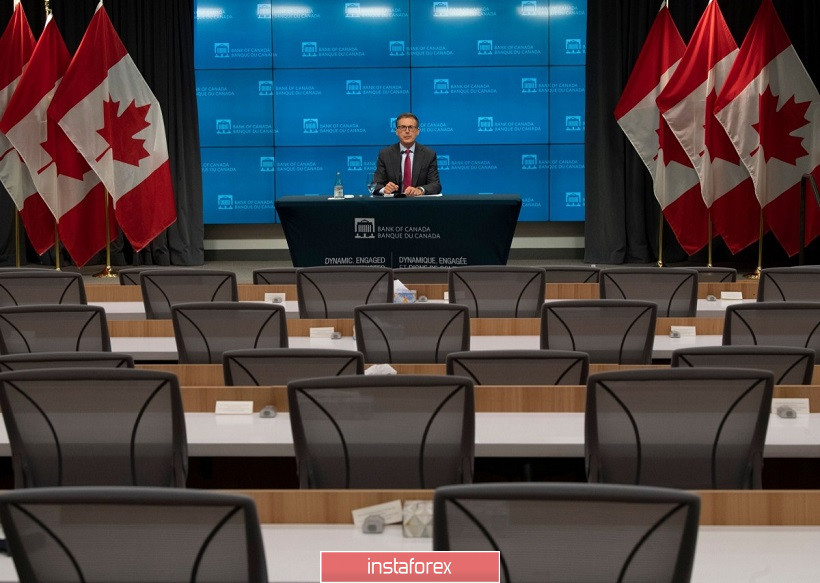The Canadian dollar reacted emotionally to the results of this year's meeting of the Bank of Canada. The USD/CAD pair lost 150 points in just a few hours, reaching the middle line of the Bollinger Bands indicator on the daily chart (1.3334). The last time the pair was at this level was almost a month ago, that was, before September ended. After that, CAD changed the price level and was trading in the range of 1.31-1.32 for almost four weeks. However, the upward impulse, driven by the dollar's general growth, quickly disappeared. Today, the pair is trying to return to its usual price range, showing a bearish mood. Thus, it is believed that USD/CAD buyers overestimated their strength, exaggerating the significance of the "dovish signals" from the Canadian regulator.

It should be noted that the Bank of Canada has maintained the status quo regarding the key parameters of monetary policy. The key interest rate remained at 0.25%, and the scale of the weekly asset purchase program remained at $5 billion. Moreover, Tiff Macklem, Central Bank's head, announced at the meeting that the scope of the stimulus program would be slowly lowered from the current 5 billion volume (per week) to 4 billion. In addition, he ended talks regarding a possible decline in the interest rate in the negative area. It should be recalled that the corresponding rumors appeared after the Bank of England and the Reserve Bank of New Zealand have similar intentions. However, Macklem spoke out categorically against such a step. He stated that negative interest rates would be such a destructive tool at this time. He also said that the bar has been raised too high for applying negative rates. In other words, Macklem made it clear that the option of lowering the rate to zero will not even be discussed by the members of the Canadian regulator in the near future. According to him, the results of Q4 will be in the positive zone, even despite the second wave of the pandemic.
Thus, Tiff Maclem did not scare traders by easing monetary policy, although he noted the presence of negative signals (details are discussed below). So if the regulator had limited itself to this rhetoric, the October meeting could be ignored.
However, traders paid attention to the fact that the Canadian regulator slightly adjusted the stimulus program, announcing that it will buy longer-term bonds. In view of this, Macklem specified that purchases of bonds within the QE framework will now apply not only to 3, 5, 10, 15-year bonds, but also to 30-year ones. In his opinion, it will maximize the effectiveness of the incentive program. The Central Bank came to the conclusion that long-term bonds have a direct impact on borrowing rates, which are more important for households and businesses. At the same time, the regulator added that the Central Bank may take additional measures, if such a need rises in the future.
It is also noteworthy that the BoC has completely ignored the latest gains from macroeconomic statistics. This is surprising, since according to the latest data, the unemployment rate in September fell immediately to 9%, which was around 10.8%. It should have fallen by only 0.4% according to general forecasts. But in fact, the indicator sharply plummeted at once by 1.8%. In turn, the growth rate of the number of employed more than doubled the forecasted values, being at around 378 thousand, instead the forecasted 150 thousand. Unfortunately, Tiff Macklem ignored this release. Moreover, he reported that the labor market is still missing more than 700 thousand jobs compared to pre-crisis levels. To sum it up, the BoC's head concluded that the risks are overall balanced, but the regulator is more focused on downside risks.

On another note, CAD is also under pressure due to the oil market. WTI oil prices (as well as for Brent) collapsed yesterday amid decisions by European leaders to tighten quarantine restrictions. According to oil traders, even moderate lockdowns will provoke a decline in demand, primarily in countries such as France and Germany.
Personally, the results of the October meeting do not look so dovish as to provoke an upward trend in the USD/CAD pair. Thus, it can be concluded that the pair is holding on to active levels only due to the increased demand for the US dollar. The ongoing panic around COVID-19 is giving a chance to anti-risk sentiment to rise. In such a situation, the USD will benefit from it, which is the main defensive asset. But as soon as the panic mood subsides, buyers of USD/CAD will have no reason to keep the price at the current level.
All this suggests that the priority in the medium-term will be short positions. At the moment, the price is located at the upper limit of the Kumo cloud on D1, which coincides with the upper line of the Bollinger Bands indicator (1.3310). This resistance level turned out to be difficult for the pair's bulls, therefore, we can consider selling with the first target at 1.3200 (the middle Bollinger Bands line, which coincides with the Tenkan-sen line) from the current positions.
 English
English 
 Русский
Русский Bahasa Indonesia
Bahasa Indonesia Bahasa Malay
Bahasa Malay ไทย
ไทย Español
Español Deutsch
Deutsch Български
Български Français
Français Tiếng Việt
Tiếng Việt 中文
中文 বাংলা
বাংলা हिन्दी
हिन्दी Čeština
Čeština Українська
Українська Română
Română

